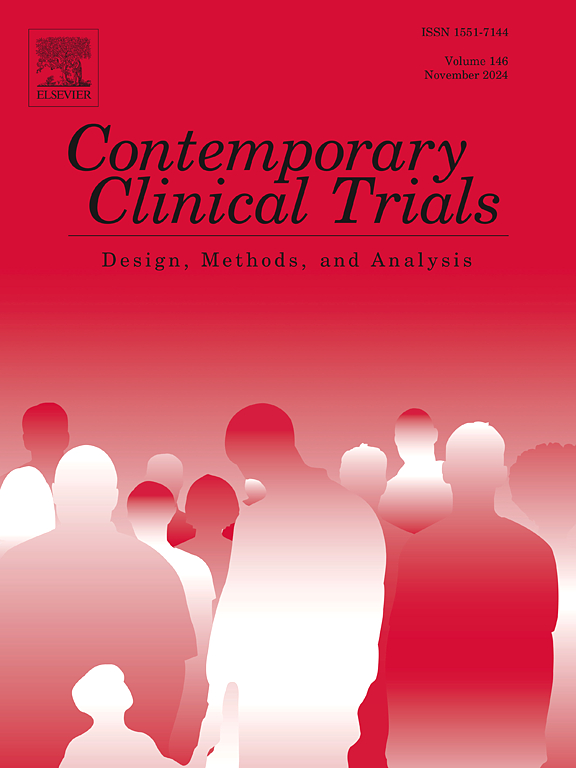Baseline sample characteristics for the BackInAction pragmatic trial of acupuncture for chronic low back pain in older adults
IF 1.9
3区 医学
Q3 MEDICINE, RESEARCH & EXPERIMENTAL
引用次数: 0
Abstract
Background
Chronic low back pain (cLBP) is a leading cause of disability, particularly among older adults. Despite this, effective nonpharmacologic treatments such as acupuncture have not been adequately studied in older adults. The “BackInAction” pragmatic clinical trial aims to address this gap by evaluating the effectiveness of acupuncture in reducing back pain-related disability among adults aged ≥65. The purpose of this manuscript is to compare sample characteristics across sites and across waves of COVID-19.
Methods
We describe participant baseline characteristics for the BackInAction trial, a three-arm randomized trial conducted across four U.S. healthcare systems: two integrated care delivery, a fee-for-service (FFS) system, and an urban federally qualified health center (FQHC). Participants (N = 800) with cLBP were randomized to receive standard acupuncture, standard acupuncture plus maintenance sessions, or usual medical care. Baseline data were collected through self-reported measures and electronic health records. Recruitment trends are evaluated during COVID waves.
Results
The sample was predominantly female (61.9 %) and non-Hispanic white (64.6 %), with an average age of 73.6 years. The FQHC enrolled a younger, more diverse and socioeconomically disadvantaged population with higher levels of back pain-related dysfunction. The FFS enrolled an older population but had similar rates of back pain-related dysfunction and pain intensity as in the integrated care delivery systems. There were no differences by site corresponding to the circulation of COVID-19 strains.
Conclusion
Findings suggest that FQHC populations have higher-than-average social and clinical risks, illustrating the complexity of delivering treatment for cLBP and the urgency to ensure such clinical environments are included in trials.
Trial registration
ClinicalTrials.gov Identifier: NCT04982315. Clinical trial registration date: July 29, 2021.
针灸治疗老年人慢性腰痛的BackInAction实用试验的基线样本特征
背景:慢性腰痛(cLBP)是导致残疾的主要原因,尤其是在老年人中。尽管如此,有效的非药物治疗,如针灸,还没有在老年人中得到充分的研究。“BackInAction”实用临床试验旨在通过评估针灸在减少65岁以上成年人背痛相关残疾方面的有效性来解决这一差距。本文的目的是比较不同地点和不同疫情的样本特征。研究人员描述了BackInAction试验的参与者基线特征,该试验是一项三组随机试验,在四个美国医疗保健系统中进行:两个综合医疗服务系统,一个按服务收费(FFS)系统和一个城市联邦合格医疗中心(FQHC)。cLBP患者(N = 800)随机接受标准针灸、标准针灸加维持疗程或常规医疗护理。基线数据是通过自我报告措施和电子健康记录收集的。在新冠疫情期间评估招聘趋势。结果样本以女性(61.9%)和非西班牙裔白人(64.6%)为主,平均年龄73.6岁。FQHC招募了更年轻、更多样化、社会经济条件较差、背痛相关功能障碍程度较高的人群。FFS纳入了老年人群,但与综合护理提供系统中背痛相关功能障碍和疼痛强度的发生率相似。不同地点对应的COVID-19毒株的传播没有差异。研究结果表明,FQHC人群的社会和临床风险高于平均水平,说明了cLBP治疗的复杂性和确保临床环境纳入试验的紧迫性。试验注册clinicaltrials .gov标识符:NCT04982315。临床试验注册日期:2021年7月29日。
本文章由计算机程序翻译,如有差异,请以英文原文为准。
求助全文
约1分钟内获得全文
求助全文
来源期刊
CiteScore
3.70
自引率
4.50%
发文量
281
审稿时长
44 days
期刊介绍:
Contemporary Clinical Trials is an international peer reviewed journal that publishes manuscripts pertaining to all aspects of clinical trials, including, but not limited to, design, conduct, analysis, regulation and ethics. Manuscripts submitted should appeal to a readership drawn from disciplines including medicine, biostatistics, epidemiology, computer science, management science, behavioural science, pharmaceutical science, and bioethics. Full-length papers and short communications not exceeding 1,500 words, as well as systemic reviews of clinical trials and methodologies will be published. Perspectives/commentaries on current issues and the impact of clinical trials on the practice of medicine and health policy are also welcome.

 求助内容:
求助内容: 应助结果提醒方式:
应助结果提醒方式:


